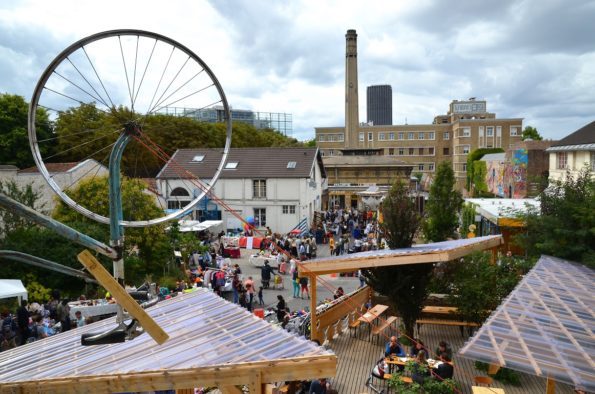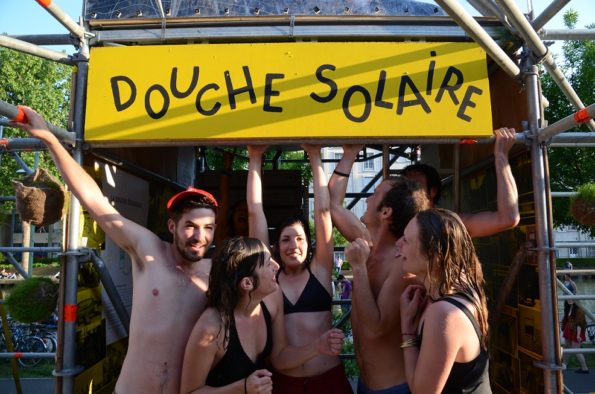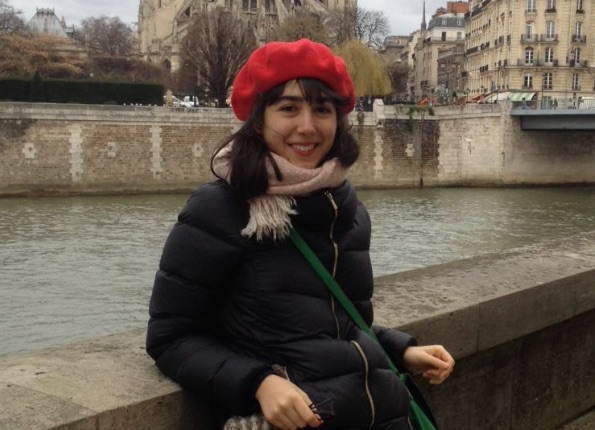Search
To search for an exact match, type the word or phrase you want in quotation marks.
A*DESK has been offering since 2002 contents about criticism and contemporary art. A*DESK has become consolidated thanks to all those who have believed in the project, all those who have followed us, debating, participating and collaborating. Many people have collaborated with A*DESK, and continue to do so. Their efforts, knowledge and belief in the project are what make it grow internationally. At A*DESK we have also generated work for over one hundred professionals in culture, from small collaborations with reviews and classes, to more prolonged and intense collaborations.
At A*DESK we believe in the need for free and universal access to culture and knowledge. We want to carry on being independent, remaining open to more ideas and opinions. If you believe in A*DESK, we need your backing to be able to continue. You can now participate in the project by supporting it. You can choose how much you want to contribute to the project.
You can decide how much you want to bring to the project.

It could be a war cry, but it’s a group of French architects that is completely changing the way of approaching town planning. Among their current projects is Grands Voisins, an ephemeral experimental space on a plot of land previously occupied by Saint-Vincent de Paul Hospital, in the heart of Paris. After a period of non-use, in 2015 three associations set up their headquarters there –Aurore, Plateau Urbain and Yes We Camp –to prepare its transformation into a future eco-neighbourhood. Halfway between providing emergency accommodation for people in precarious situations and gentrified ‘bobo’ [bourgeois-bohème] towns (consisting of artists’ studios and co-working spaces, allotments and artistic campsites, among others), the second session of the Grands Voisins, which was not initially foreseen, has just opened. We chatted with Raphaël Haziot, artistic coordinator of Grands Voisins for Yes We Camp.
You describe your activity as an exploration of the possibilities of dwelling differently and of building and provisionally inhabiting shared spaces. These are ideas you share with other groups and associations that follow what could be considered a global trend in citizens’ re-appropriation of public space. What do you think are the social, political and economic reasons behind all these groups? It must be something that’s in the air.
As a group, we’ve never adopted a stance on these issues. Personally, I believe that there are several factors. On the one hand, the fact of being passive consumers is very recent in history, but we are now at the end of this cycle. It had been associated with growth, although it has been at a standstill for years. On the other hand, a series of increasingly important ecological problems lead us to wonder whether we can consume in a different way, inhabit in a different way, travel in a different way. Another factor is Internet culture, open source and co-construction logics that inspire ways of thinking that are applicable to architecture and town planning. So, the idea of committing ourselves to great projects … even in these cases there is quite a strong commitment, although it is far from being a political or militant scenario. We don’t have a political stance. We don’t debate at a political level — we stand apart from politics, we’re at another level.
Inhabiting in a new way and building provisionally shared spaces are the two aspects that define our identity. The latter is related to terms such as transitory urbanism and temporary occupation that will come to the fore in the next few years. The Grands Voisins is a closed place, characteristic of transitory urbanism. People have the impression of arriving at a utopian village, because it is completely cut off from the street and there is only one entrance. This is what we do: we occupy places temporarily, we inhabit them and make them into shared spaces of authority, and then we move on. As regards human relations, inhabiting in a different way implies adventure, transitoriness and this leads to nomadism. In the association, we are all fans of camping — we are quite mobile and travel around a lot on bikes. We stand up for our nomadism, also because of the transient nature of the projects. Once again, it’s something personal; we’ve never actually said that one of the strong points of the association is mobility or nomadism.
You say that this transitory urbanism will come to the fore in the next few years.
Provisional occupations are a growing phenomenon, a general trend, and yet we should ask ourselves who benefits from this trend. We arrive at a place, we invigorate it and its value increases — the capital gains of property usually benefit private developers. In the Vive les Groues project in Nanterre we tried to introduce an innovative financing system according to which the developers pay for the prefiguration: we planted three thousand trees that will subsequently remain in the future neighbourhood, and the developers who will benefit from the capital gains must finance the prefiguration. But it’s not easy to explain, particularly because so far the temporary occupation projects have been self-funded, so the impression is that they are free when this is not the case. We work hard; we all devote ourselves to the bar in order to finance the project of the association [the collective manages La Lingerie bar, in the heart of Grands Voisins, that also organises weekly concerts].
You spoke of spaces of authority. What do you mean by that?
At the association we’re forever asking ourselves what we’re doing: building spaces of authority. We live in an increasingly fractured world, in a state of emergency. We tend to withdraw into our homes. Cities are increasingly less happy and welcoming spaces, so we try to create places where everyone may feel legitimate, regardless of their social class or condition. This isn’t easy on the street. On the street, if someone comes up to speak to us, by definition there will be a presumption of mistrust: they will have to prove they are nice because they are automatically suspicious. Here it’s the other way round: in the places we are creating there is a sort of presumption of trust towards others, so it is important that we spontaneously tell ourselves that there are things we can do with these people.
Spaces of authority are qualifying places. Nobody wants to be merely a passive consumer. Knowing how to build them is always much more interesting, so the idea is that the project be co-built with the people, that everyone should have a space of their own and authorisation to do things, for which people must feel qualified, invited and welcome.
Returning to the idea of this line of work on the community, public space, the square, etc., there are many similar projects in Spain. I’m thinking of Basurama, with whom you’ve recently collaborated. Do you share projects with collectives abroad? Do you network?
A short time ago we went to an event organised by Basurama, a workshop. We have other planned in june and october, in Taiwan. There’s another group in Hamburg to which we also feel close, and we’re quite familiar with French collectives. Also with Burb, from Italy, who have invited us to build a camping site in Venice, Esperienza Pepe. We would like to network more, but it’s still too early; for the time being we’re trying to get organised and complete with everything we’re working on here. Our economy is quite fragile too, so it’ll be a while before we can develop projects abroad. If we manage to stabilise ourselves one day, of course we’ll develop them to the full, at least in France.
We could say that the work in public space belongs to a genealogy in which you are the last link. I’m thinking of the avant-garde, of Surrealists and Dadaists, and then in the sixties of Henri Lefebvre and the Situationists, who revisited these ideas … I don’t know whether you claim to be their heirs.
The difference is that avant-garde trends always entail breaking with tradition. We don’t do things against others, just separate from them. But if we were to choose between Surrealism, Dadaism, etc., I think we’d be closer to the Bauhaus movement. And GRAV, an important reference for the group. Then again, in artistic terms, there is the notion of the independence of art, which is very difficult to sidestep. In all our projects the idea is to arrive at a sort of desacralisation of art. For us, art is an instrument to achieve a connection between many things, between architecture, human relations, etc.

You practice interdisciplinarity.
No, transdisciplinarity: it’s not a question of everyone having their own discipline and comparing it to others, but of creating things that are indefinable. In the association, responsibilities are divided up: construction, layout, conception, artistic devices, etc.
Earlier on, speaking of what people perceive of the Grands Voisins, you mentioned the term utopia. What is your relationship with utopia?
None of our reflections are in terms of utopia. Utopia is a projection in the future, a point to be reached, and we live only in the present, in the concrete, and we have a strong lack of definition. Here, for instance, we’re experiencing how a temporary occupation can have a bearing on the programme that was planned for the future eco-neighbourhood. This sort of practice brings us face to face with our methodology. We devise our projects gradually, according to what comes up. We don’t have a defined programme but accept a certain degree of indeterminacy, which means our programme is subject to continuous changes. This where there is a gap with respect to great town-planning projects, the timings of which are always extra-long and are always supposed to be definitive. All urban projects, all plans, are conceived and designed as if they were written in stone; the time dimension is never contemplated, and yet everything is temporal.
There’s also the question of the local. There is a universalising dimension in utopia, a conceptualisation of the model of society, but in point of fact the model of society adapts to local circumstances and to their people. Creating with people forms a part of the indeterminacy I was describing. If you create with people and their proposals you never know in advance what you’ll end up creating.
What sort of integration work does Yes We Camp do at the Grands Voisins? Do you carry out inclusive urbanism actions?
Ours is inhabited architecture, not projected architecture. We don’t design architectural objects, but buildings that meet certain uses — we design them according to their utility. Given that we think in terms of uses, people are a key part of our activity. Our relationship with social work appeared by chance, through a meeting with Aurore association at the Grands Voisins. Our statutes defend the combination and coexistence of different audiences, so we work on projects that have a strong social dimension, projects that address social dysfunctions. Such a lack of temporary structures for social accommodation implies a huge shortage of accommodation for the number of homeless on the streets. This provisional place hopes to fulfil the wishes that cannot be met outside.
Three months after its closure, the Grands Voisins reopens in April for a second session that is scheduled to remain open until 2020. Will it be an exact continuation of the former?
There is obviously a change in the project. When we arrived all we found was a deserted hospital. Initially, we intended to stay four months and the atmosphere was that of a workshop. It’s different now because there’s a divide between the two, but we aim to follow the same dynamic. The idea is to take time to reflect, to open up to the neighbourhood, which we didn’t really do in the first session. There’s also a huge challenge of shared governance that didn’t exist earlier. Before, everything was built very empirically — we didn’t have time to reflect, and now we’ve realised that this caused a certain degree of frustration in the organisations. Today the project is run by Aurore, Plateau Urbain and Yes We Camp, but the idea is that instead of being the only ones steering, we share control with the organisations and residents, through the creation of mixed committees for the selection of projects, for instance.
To return to the question of the temporary, wouldn’t you be able to make a deeper mark on projects if these were more long-term? If the Nanterre project were to last eight years, for instance?
It always depends on how the issue is posed. The Grands Voisins, for example, will end up having an impact on the future eco-neighbourhood. In Nanterre this was the objective from the very beginning — it is a tree nursery in an area measuring 3000 square metres, and the trees will then be replanted throughout the neighbourhood. So, by definition, the project will have an impact on the lifespan of the trees. There’s also the question of a longer-term settlement and what purpose that would serve. We’d have to see; it’s not something that’s under consideration.
It’s a shame that the Grands Voisins will be closing down in two years’ time. I’m thinking, above all, of the residents, because the project is magical for visitors and tourists, but it’ll create a fracture in the lives of the residents.
If they weren’t in the Grands Voisins, the residents would be lodged somewhere else. It’s just that the place allows us to work on reintegration, but the project has its own idiosyncrasy — originally we were going to stay for six months, then for a year and finally we decided on two years. All the energy was instilled in the project at the beginning, because it was ephemeral. If that hadn’t been the case, the Grands Voisins wouldn’t be the same. Then there’s the question of rules (the rules governing architecture and town planning), which are quite paralysing. Precisely because we find ourselves recording the events, we have great liberty for building, inspiring and producing things. Besides, if it lasted twenty years we don’t know how we’d go about it, because we’re not at all used to that way of working. I think we’d be there for five years, and after that we’d give the keys to another group. It might be interesting to have a rotation of groups.
Anyway, you’re in a very young team. The age average is …
Twenty-eight.
And you’ll be taking part in the next Venice Biennale as representatives of France, together with other groups and structures. I suppose that will mark a before and after. It’s a great project.
Yes, it’s a sign of recognition. We’re more devoted to making, to experiencing things. That’s why we are participating in the camping in the Lido. A big adventure.
But the Biennale would entail the institutionalisation of the collective. What sort of relationships do you have with institutions?
We’re not totally against institutions, because we all need them. Nobody can be entirely anti-institution. The question is whether we choose revolution or transformation, and we prefer metamorphosis to radical rupture. But only the future will tell how the institutionalisation of this sort of project may turn out.
And in the case of Council of Paris, in the case of the Grands Voisins, do you need the support of a large public entity and legitimation?
At the beginning, we financed and set up the project on our own. What has helped us has been a great laissez-faire. We’ve been living in this state of self-sufficiency for quite some time. And then the situation changed. Now we’re talking to the council and we have its support. So our relationship with institutions is the same as our relationship with rules, i.e., always ambivalent: sometimes we support self-management, and other times the institution.

Beatriz Sánchez Santidrián had always wanted to be a biologist but she grew up amidst books, records, films and exhibitions; a few days before enrolling at university she decided that what interested her most was Art History. Dreaming of the bohemian intellectuals of postwar Paris, she settled there. She hasn’t run into Beauvoir or Cocteau, but she’s still there. Still looking.
"A desk is a dangerous place from which to watch the world" (John Le Carré)